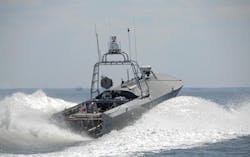Textron to build unmanned counter-mine enabling technologies using high-temperature superconducting magnet
ARLINGTON, Va. – U.S. Navy researchers needed counter-mine technologies for a future long-endurance, semi-autonomous, diesel-powered boat for counter-mine operations. They found their solution from Textron Systems Corp. in Hunt Valley, Md.
Officials of the Office of Naval Research in Arlington, Va. announced a $20.8 million contract to Textron earlier this month for the Magnetic and Acoustic Generation Next Unmanned Superconducting Sweep (MAGNUSS).
MAGNUSS will have a high-temperature superconducting magnet with an advanced acoustic generator, and will go aboard the future Mine Countermeasures unmanned Surface Vehicle (MCM-USV). The MCM USV program use several payload delivery systems to include the minesweeping payload delivery system, minehunting payload delivery system, and future payload delivery systems for mine neutralization.
The Navy has been moving the mine countermeasures mission to the Littoral Combat Ship (LCS) as a suite of mission modules like the MCM-USV as a deployable system on the LCS to complete the minesweeping mission. The Office of Naval Research, meanwhile, has been developing an advanced closed-loop minesweeping system using an high-temperature superconductor magnet coupled with an acoustic source to generate underwater acoustic energy.
The advantage of using an high-temperature superconducting magnet is the ability to run at very high electrical currents with near-zero resistance, which can sweep magnetic influence mines when coupled to an acoustic generator.
In addition to the recent advancement of high-temperature superconductor magnets to provide a non-towed magnetic source, Navy researchers want a non-towed, underwater acoustic source with low-drag as an alternative to a legacy acoustic generator that still enables additional benefits to the non-towed magnetic source.
The modularity of the high-temperature superconductor magnet and acoustic generator potentially could be deployed on any craft of opportunity -- not just aboard the MCM-USV.
Textron engineers will integrate the high-temperature superconductor magnet, acoustic generator systems, and command and control for deployment onboard a small craft like the MCM-USV.
The company will build a high-temperature superconductor magnet and an acoustic generator; integrate the mechanical, electrical, and command and controls (C2) systems of the two systems with each other; and integrate the complete payload with the MCM-USV and its hull for demonstration.
On this contract Textron will do the work in Ayer, Mass; Hunt Valley, Md.; and Groton, Conn., and should be finished by March 2026. For more information contact Textron Systems online at www.textronsystems.com, or the Office of Naval Research at www.nre.navy.mil.

John Keller | Editor-in-Chief
John Keller is the Editor-in-Chief, Military & Aerospace Electronics Magazine--provides extensive coverage and analysis of enabling electronics and optoelectronic technologies in military, space and commercial aviation applications. John has been a member of the Military & Aerospace Electronics staff since 1989 and chief editor since 1995.

